Key takeaways:
- Resistance to change often stems from fear of the unknown and personal insecurities, making open dialogue essential for easing transitions.
- Child safeguarding is crucial for protecting children and fostering a safe environment, which ultimately shapes responsible future generations.
- Effective strategies to overcome resistance include active listening, providing training, celebrating small wins, and sharing personal experiences to build emotional connections.
- Transparency and resilience are key to navigating change, helping to foster trust and maintain momentum during transitions.
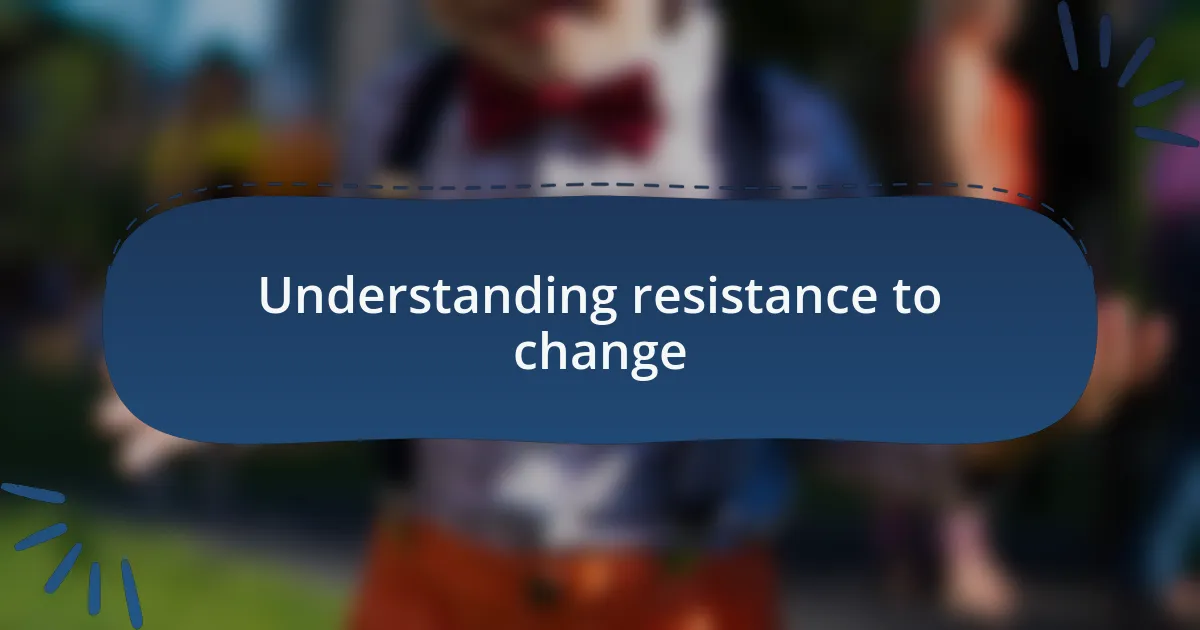
Understanding resistance to change
Change often triggers a natural instinct to resist. I remember a time when a new policy was introduced at the organization I worked with, intending to improve child safety measures. Many of us felt anxious about the implications it would have on our daily routines, fostering a sense of uncertainty that made it hard to embrace the change fully. Isn’t it interesting how our minds often cling to the familiar, even when we know that change can lead to improvement?
Often, resistance stems from fear—fear of the unknown or fear of feeling inadequate in adapting to new expectations. I recall speaking with a colleague who shared her worries about implementing a new reporting system. She felt it would expose gaps in her skills that she wasn’t ready to confront. Questions like, “What if I can’t learn this quickly enough?” lingered, highlighting how personal insecurities can fuel resistance.
Understanding this emotional landscape is crucial. I’ve learned that creating an open dialogue about these feelings can be transformative. When we openly discussed our fears during team meetings, it not only reduced individual anxieties but also fostered a supportive environment where everyone felt heard. Have you had similar experiences where addressing underlying emotions helped ease the transition to change?

Importance of child safeguarding
Child safeguarding is essential because it ensures the protection of children from harm, abuse, and neglect. In my work, I’ve seen firsthand the difference that a robust safeguarding framework can make in a child’s life. It’s not just a set of policies; it’s a commitment to creating a safe environment where children can thrive emotionally and physically.
Reflecting on a specific situation, there was a case where a child disclosed their experience of bullying, and the safeguarding procedures activated an immediate response. This safety net gave the child the courage to speak out, ultimately leading to significant improvements in their well-being. It’s moments like these that reinforce how vital safeguarding measures are—not only in protecting children but also in empowering them to share their experiences without fear.
Moreover, the broader societal implications of child safeguarding cannot be ignored. When we prioritize the safety of our children, we invest in future generations. I’ve often thought, what kind of society do we want to build? Protecting children today means fostering responsible, caring adults tomorrow. These reflections remind me that every effort in safeguarding contributes to a more resilient and compassionate community.
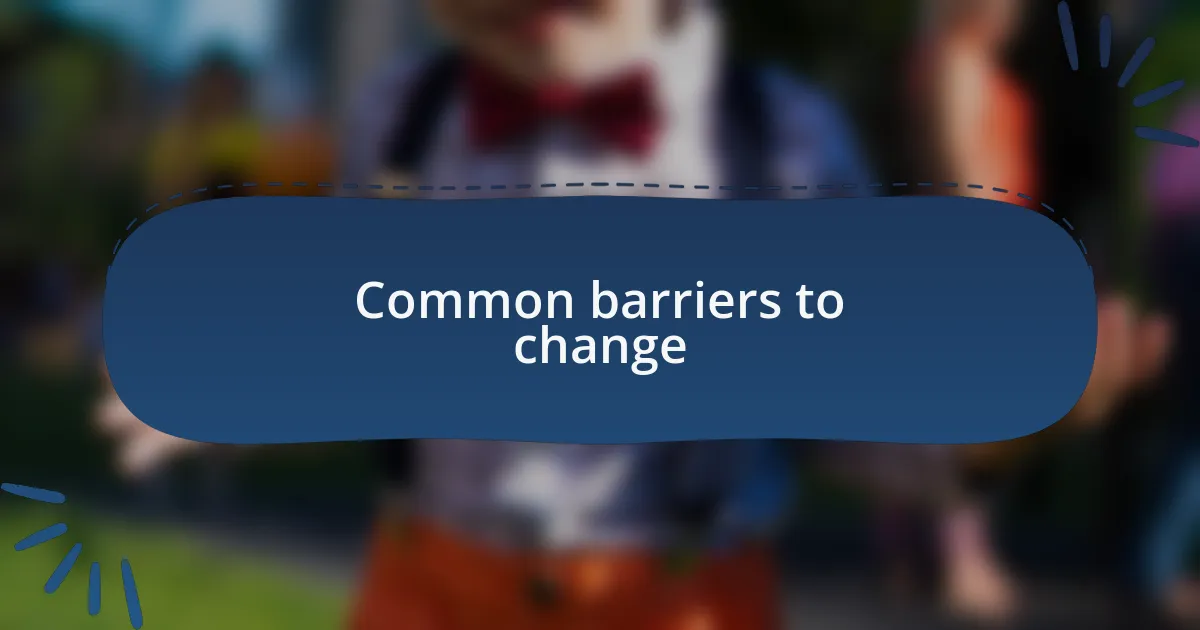
Common barriers to change
Changing established practices in child safeguarding often faces several barriers that can impede progress. One significant barrier is resistance from staff who may feel comfortable with the status quo. I recall a team meeting where a colleague expressed concern that proposed changes would disrupt their routine. It surprised me how deeply ingrained some habits can be, even when the potential benefits are clear.
Another common obstacle is a lack of training or understanding about new policies. I once encountered a situation where staff members hesitated to implement a new reporting procedure simply because they weren’t adequately briefed on it. This experience taught me that without proper education on the importance of these changes, skepticism can easily arise, leaving everyone feeling uncertain.
Fear of accountability also looms large as a barrier to change. In a previous role, I noticed that some individuals were reluctant to embrace new safeguarding measures due to worries about being held responsible for mistakes under the new system. It makes me ponder: how can we create an environment where staff feel safe to take calculated risks in service of the children? Encouraging open dialogue about these fears is crucial if we hope to facilitate a smoother transition to improved practices.
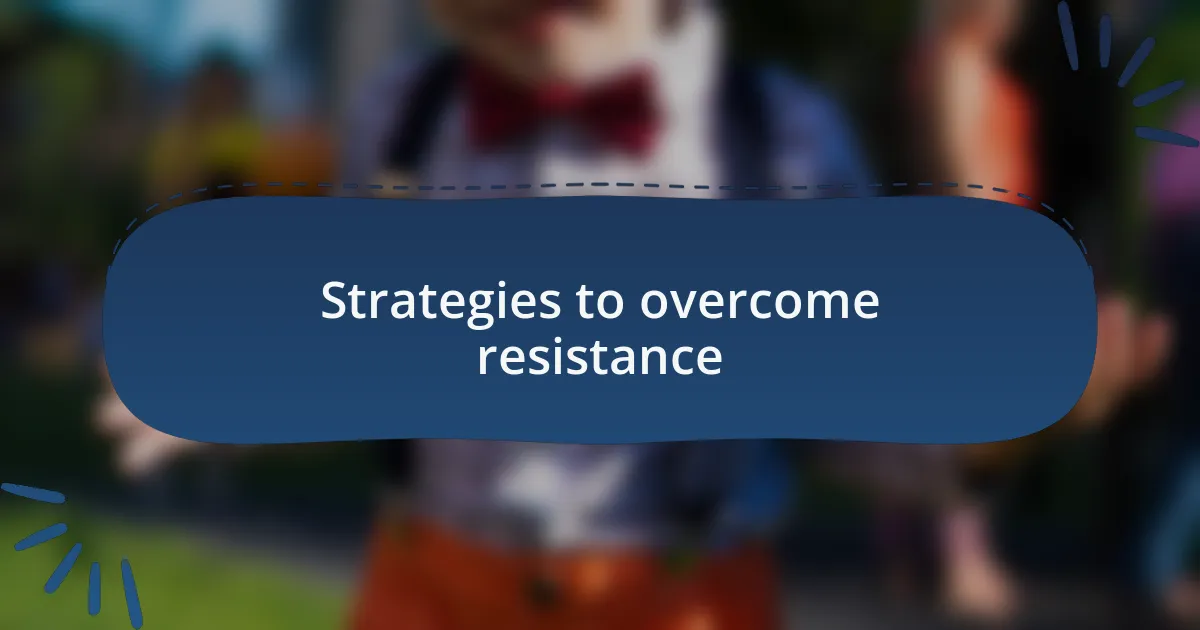
Strategies to overcome resistance
Acknowledging resistance is the first step toward overcoming it. One effective strategy I’ve found is to engage in active listening. When I worked with a group resistant to a new safeguarding protocol, I took the time to individually meet with team members to understand their concerns. It was enlightening; many felt unheard. By addressing their fears and involving them in the dialogue, I witnessed a shift in attitude where they became advocates for change rather than obstacles.
Another strategy that proved invaluable in my experience is providing continuous support and training. For instance, during a transition to a digital reporting system, we organized hands-on workshops that allowed our staff to practice using the new tools in a safe space. I saw how this practice lifted their confidence and transformed skepticism into a sense of ownership. Have you ever noticed how powerful a little knowledge can be? Empowering individuals to learn can dismantle reluctance.
Ultimately, celebrating small wins during the change process makes a remarkable difference. I remember implementing a new child safeguarding policy and making it a point to acknowledge individual contributions to its success. Recognizing these moments created a positive atmosphere, motivating others to embrace change fully. How could we maintain this momentum and encourage a culture of continual improvement? Acknowledging every step forward can make change feel less daunting and more rewarding.
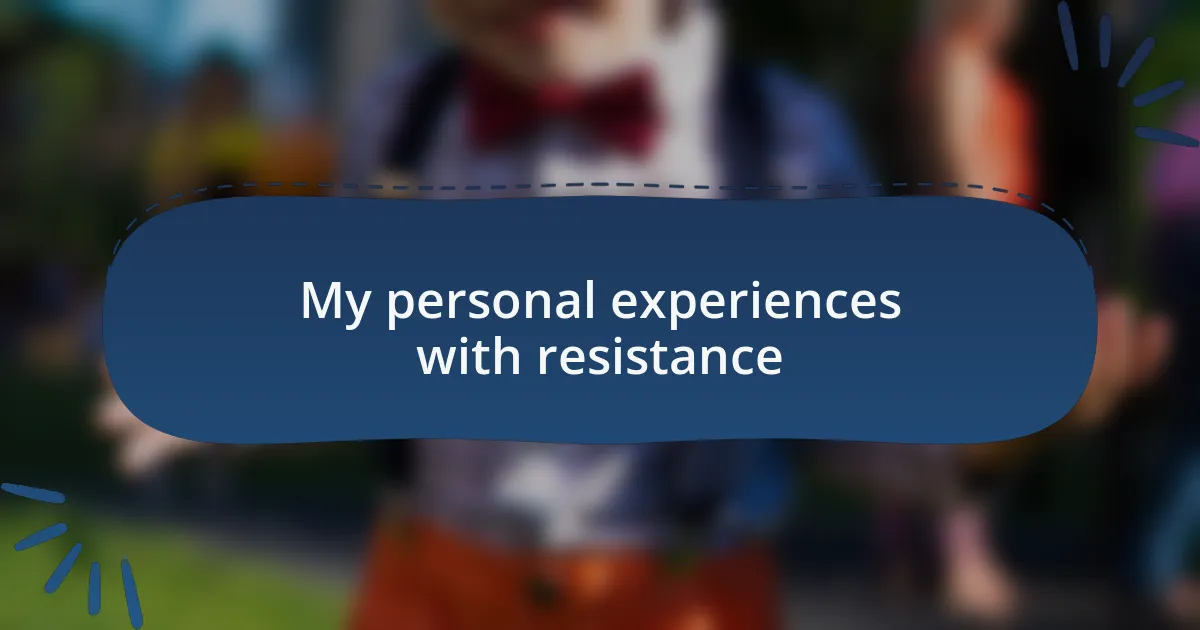
My personal experiences with resistance
My personal experiences with resistance have often revealed the complex emotions at play. I recall a specific instance when I introduced a new reporting policy for safeguarding cases. Some colleagues openly resisted, expressing frustration and anxiety about the additional workload. It struck me how fear can manifest as resistance; rather than dismiss their concerns, I chose to empathize, sharing my own trials when adapting to change. This connection often turned tensions into discussions.
One particularly challenging moment stood out when I led a meeting to discuss a new collaborative approach. Initially, the room felt heavy with skepticism, as a few members were vocal about their disbelief in the efficacy of the proposed changes. I decided to share my initial resistance when I first encountered similar protocols. By being vulnerable, I saw others soften their stances, realizing that change is a shared journey of learning and unlearning. Isn’t it interesting how our shared experiences can build bridges?
Throughout these experiences, I learned that resistance isn’t solely about pushback; it often stems from a place of caring deeply about the work. When I was part of a transition to a child safeguarding framework, I noticed that many who questioned the change were deeply invested in the well-being of the children we served. Reflecting on this made it clear that addressing resistance requires understanding the underlying passions and fears. How often do we pause to consider the motivations behind resistance? This awareness transformed my approach, helping me turn potential conflicts into opportunities for dialogue and growth.
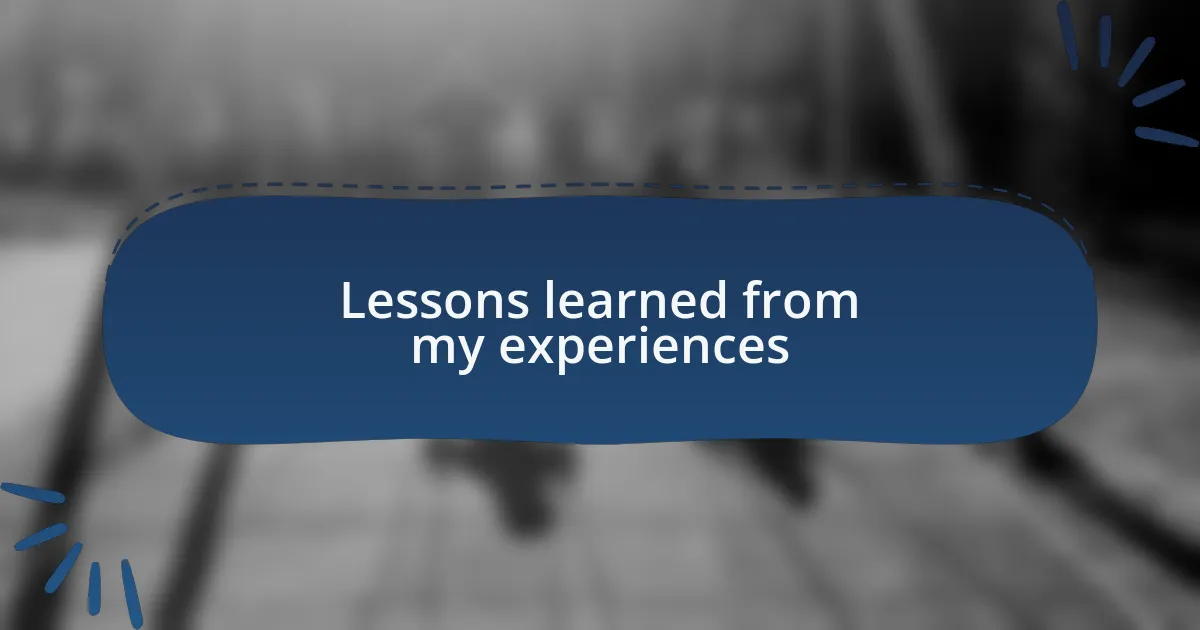
Lessons learned from my experiences
In my journey, I’ve come to realize that patience is crucial when addressing resistance to change. For instance, I remember a time when we implemented a new training module. I noticed my team members struggling not just with the content but with how it challenged their established routines. Instead of pushing through, I took the time to hold one-on-one sessions, allowing them to voice their concerns and frustrations. This experience taught me the importance of giving space for people to process change, highlighting that resistance often comes from a place of fear regarding the unknown.
Emotional connection has proven to be a powerful tool in overcoming resistance. During a particularly heated discussion about adapting our protocols for reporting incidents, I shared a story from my early days in safeguarding, where I made a significant mistake due to an outdated system. This vulnerability sparked a candid conversation. It reminded me that sharing our own struggles can create a safe environment for others to express themselves. How often do we hesitate to share our missteps, even though they resonate deeply with others?
Additionally, I found that seeking feedback can fracture the walls of resistance. At one point, after introducing new guidelines, I held an open forum to gather thoughts and suggestions. To my surprise, many participants voiced constructive ideas, revealing that they weren’t opposed to change itself but rather the way it was introduced. I’ve learned that by genuinely inviting feedback, we not only empower our colleagues but also co-create a sense of ownership in the process. Isn’t it fascinating how collaboration can transform fear into active participation?
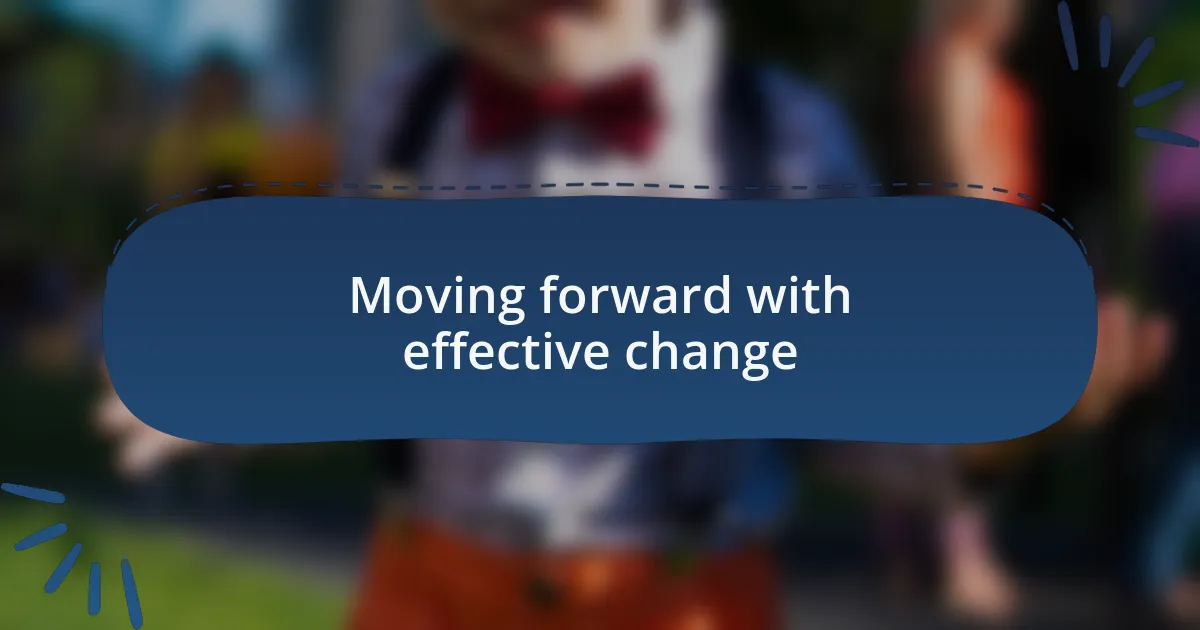
Moving forward with effective change
When it comes to moving forward with effective change, I’ve often found that transparency can be a game-changer. I recall a time when we rolled out a new child safeguarding policy; I made it a point to explain not just the “what,” but the “why.” By clearly communicating the rationale behind the changes, I saw how it transformed skepticism into support. People are naturally curious and apprehensive about change—aren’t we all? Having clarity helps ease those fears and cultivates a sense of trust.
Equally important is celebrating small wins throughout the change process. During one of my previous initiatives, we introduced a new reporting system that received mixed reactions. Initially, I focused on the challenges, but it dawned on me that every step toward implementation deserved recognition. When one team successfully submitted their first complete report using the new system, we celebrated that milestone together. I found that acknowledging progress keeps morale high and motivates others to engage. Why is it that sometimes we forget to celebrate achievements, no matter how small?
Lastly, resilience plays a crucial role in navigating change. I once faced a setback when a previously enthusiastic group began to withdraw their support. Feeling disheartened, I took a moment to reassess our strategy and consulted with a few team members. It reminded me that setbacks are not failures; they’re simply opportunities to recalibrate. How often do we let a moment of resistance halt our progress, rather than using it to strengthen our resolve? Embracing resilience allows us to adapt and move forward, fostering a culture that thrives on continuous improvement.